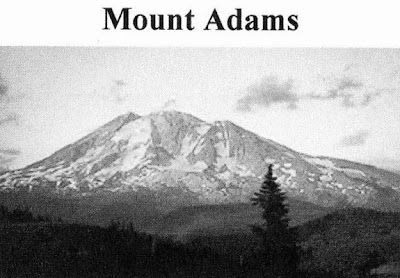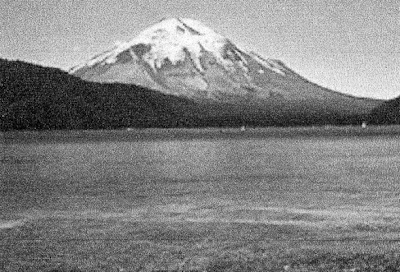We were up early the next
morning as we prepared to return to college.
Traveling back through Portland, using the route we had arrived on
didn’t look good for hitch hiking. We
decided to travel up the Washington side of the river until we could cross at
the Bridge of the Gods and onto the four lane highway we had traveled down
on. Dewey’s brother offered to drive us
up as far as the Bridge. That would give
us a good start. After a substantial
breakfast and a round of hugs and thanks, we piled into the car and headed for the
bridge.
While driving to the Bridge,
Dewey explained how it got its name and told me of the Indian legions
associated with it. Scientists believe
there was an ancient bridge formed about 1,000 years ago when a giant landslide
from the north shore of the Columbia River blocked the Gorge and stopped the
river’s flow. This natural dam created
an inland sea in eastern Oregon, Washington and into Idaho. Over time, water eroded the dam and created
an awesome natural stone bridge.
Eventually, this fell, creating the Cascade rapids.
The modern bridge was started
in 1920 and was modified in 1938 to accommodate the rise in water level caused
by the backwater behind Bonneville Dam.
The finished structure has a cantilever main span with anchor arms on
either side. The total length of the
structure is 1,858 feet with a width of 35 feet. It rises 140 feet above the water which is
108 feet deep at that point. The Bridge
of the Gods serves as a link for hikers on the Pacific Crest Trail to cross the
Columbia River to continue their journey onto Washington State. Crossing the Columbia River at this point is
the lowest elevation in the 2,600 mile journey of the trail. That is a lot of detail but I found it
interesting.
I also found Indian legions a
most interesting part of the bridge story and there were several. This
is my favorite as recounted by the current owners of the bridge, the Port of
Cascades locks.
“Native American legions also speak of
the creation and destruction of a natural bridge. The people of the Columbia River had great
difficulty crossing the Columbia River.
Manito, the Great Spirit, was sympathetic and built a stone bridge for
them. The stone bridge, called the great
crossover, was so important that Manito placed Loo-Wit, an old and wise woman, as
its guardian.
Over time, the People began to fear that the bridge
would wash away, and they appealed to the Great Spirit. Manito agreed to protect the bridge and the
grateful people gave it a new name, the Bridge of the Gods. At about that
same time, Manito also sent to earth his sons- three great snow mountains, Multnomah,
the warrior (MT.Rainier),
and Wy’east, the singer (Mt. Hood).
.. All was peaceful until beautiful Squaw Mountain moved into a small valley between Klickitat and Wy’east.
Squaw Mountain grew to love Wy’east, but though it
great fun to flirt with Klickitat, his big, good–natured brother. Soon a rivalry sprang up between the two
brothers over Squaw Mountain.
They argued, growled, stomped their feet, spat ashes and belched great clouds of black smoke. Each hurled white-hot rocks, setting fire to the forest and driving the people into hiding. Finally, they threw so many stones onto the Bridge of the Gods and shook the earth so hard that the bridge broke in the middle and fell into the river.
They argued, growled, stomped their feet, spat ashes and belched great clouds of black smoke. Each hurled white-hot rocks, setting fire to the forest and driving the people into hiding. Finally, they threw so many stones onto the Bridge of the Gods and shook the earth so hard that the bridge broke in the middle and fell into the river.
Upon hearing this, Manito was angry and in punishment
for the destruction of the bridge he caused a series of huge rapids to form in
the river.
Meanwhile, Klickitat won the fight over Squaw Mountain
and Wy’east admitted defeat. This was a
sever blow to Squaw Mountain as she loved Wy’east. Though she took her place with Klickitat,
her heart was broken, and she sank into a permanent deep sleep. She is known today as Sleeping Beauty and
lies where she fell, just west of Mt. Adams.
When this happened, Klickitat had a high, straight
head, like Wy’east. But Klickitat truly
loved Squaw Mountain, and the fate caused him such grief that he dropped his
head in shame and has never raised it again.
During the war Loo-Wit, the guardian of the bridge,
tried to stop the fight but she failed and fell with it. The Great Spirit heard of her faithfulness
and promised to give her a wish. She
asked to be made young and beautiful once more. However being old in spirit she did not desire
companionship The Great Spirit granted
Loo-Wit her wish. She is now known as
the youngest mountain in the Cascades, the beautiful and powerful Mt. St. Helens.
As Paul Harvey always said, “here’s the rest of the story” Now, suppose you could look ahead 27 years; this is
what Mt. St. Helens looked like two years after a major eruption in 1980.
Listening to these tails made the time fly and soon we pulled into the parking lot at the Washington end of the Bridge of the Gods. It was a beautiful site with the steel structure shining in the morning sun. We had decided to walk across the bridge to get the full impression of its height. We said goodbye and thanked Dewey’s brother, grabbed our belongings and headed for the bridge. Out in the middle there is less structure around you and the 140 feet to the water seemed a long way down. I had never been bothered by heights but this structure made me feel a little squeamish. I was glad when we reached the other side. The main highway was only a short distance so we started our quest for a ride.
*Taken from "Which Road Should I Follow?, Volume 1, Growing up in the country", an autobiography by Edwin K. Hill
Listening to these tails made the time fly and soon we pulled into the parking lot at the Washington end of the Bridge of the Gods. It was a beautiful site with the steel structure shining in the morning sun. We had decided to walk across the bridge to get the full impression of its height. We said goodbye and thanked Dewey’s brother, grabbed our belongings and headed for the bridge. Out in the middle there is less structure around you and the 140 feet to the water seemed a long way down. I had never been bothered by heights but this structure made me feel a little squeamish. I was glad when we reached the other side. The main highway was only a short distance so we started our quest for a ride.
*Taken from "Which Road Should I Follow?, Volume 1, Growing up in the country", an autobiography by Edwin K. Hill





No comments:
Post a Comment